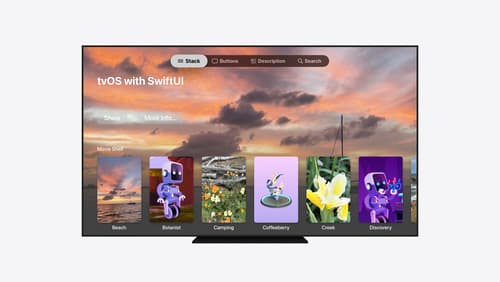What’s the latest in responsive UI?
Asked on 2024-07-31
1 search
The latest in responsive UI was covered in several sessions at WWDC 2024, focusing on both UIKit and SwiftUI enhancements.
UIKit Enhancements
In the session What’s new in UIKit, several key features were introduced to improve the user interface:
- Document Launch Experience: Redesigned to give full control over launch views and support for template document creation.
- Tabs and Sidebar Updates: Major updates to tabs and sidebar, including new fluid transitions across the system.
- SwiftUI Animations in UIKit: Improved integration between UIKit and SwiftUI, allowing for more seamless animations and transitions.
SwiftUI Enhancements
In the session What’s new in SwiftUI, several new features were highlighted:
- Flexible Sidebar and TabView: The sidebar has become more flexible, allowing users to switch between a sidebar and a tab bar representation. The tab bar can now float above the content and be customized by reordering items and hiding infrequently used options.
- Presentation Sizing: Unified and simplified across platforms, allowing for perfectly sized sheets with form or page, or even custom sizing.
- Zoom Navigation Transition: A new transition to make expanding information look more appealing.
- Custom Resizable Controls: New APIs to create custom resizable controls like buttons and toggles.
SwiftUI Essentials
In the session SwiftUI essentials, it was emphasized that SwiftUI automatically provides adaptivity along several dimensions, such as:
- Dark Mode and Accessibility: Built-in support for dark mode and several accessibility features like dynamic type.
- Localization: Easy previewing of different languages and right-to-left text support.
- Interactive Previews: Xcode previews allow for interactive testing of views in different contexts without needing to run the app repeatedly.
Platforms State of the Union
In the session Platforms State of the Union, it was mentioned that SwiftUI is designed to work seamlessly across all Apple devices, focusing on describing the UI rather than the exact visual construction. This allows for:
- Code Sharing Across Devices: More code can be shared across different devices.
- Custom Animations: Setting up animations on UIKit or AppKit views and driving them with SwiftUI, including fully custom animations.
These sessions collectively highlight the advancements in responsive UI, making it easier to create adaptive, flexible, and visually appealing user interfaces across all Apple platforms.

Get started with HealthKit in visionOS
Discover how to use HealthKit to create experiences that take full advantage of the spatial canvas. Learn the capabilities of HealthKit on the platform, find out how to bring an existing iPadOS app to visionOS, and explore the special considerations governing HealthKit during a Guest User session. You’ll also learn ways to use SwiftUI, Swift Charts, and Swift concurrency to craft innovative experiences with HealthKit.

Platforms State of the Union
Discover the newest advancements on Apple platforms.

Migrate your TVML app to SwiftUI
SwiftUI helps you build great apps on all Apple platforms and is the preferred toolkit for bringing your content into the living room with tvOS 18. Learn how to use SwiftUI to create familiar layouts and controls from TVMLKit, and get tips and best practices.
